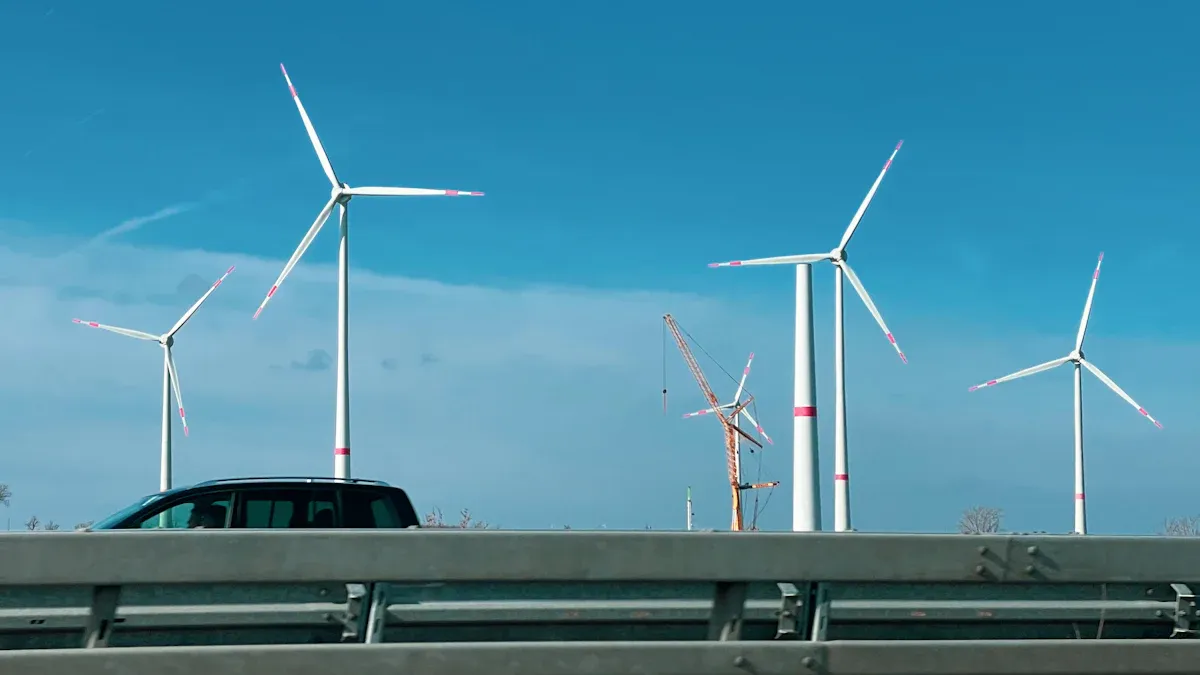Using AI for Sustainable Living

You’ve likely seen changes in the environment—hotter days, fewer trees, and strange weather. These problems mean we need to care for Earth better. This is where using AI can help. AI tools are improving eco-friendly living with clever ideas. For example, using AI might cut world carbon pollution by 15% by 2030. Amazing, right?
Key Takeaways
AI helps cut down energy waste at home and work, saving money and resources.
AI-powered smart grids manage energy better, using solar and wind efficiently.
AI tools assist farmers in using resources smartly, reducing waste and growing better crops.
Using AI for Energy Efficiency

Optimizing energy use at home and in industries
Do you know how much energy your home wastes? With AI, you can save energy and money. Smart devices, like thermostats, collect data. AI studies this data to find wasted energy. Then, it suggests ways to save energy. For example, AI can change heating or cooling based on weather or your routine. This keeps you comfy while using less energy.
In factories, AI makes energy-saving even better. It checks machines to find problems. Fixing these saves energy and cuts costs. By 2050, AI could lower energy use by 19%. In some cases, it might save up to 50%. That’s a big win for the planet.
Here’s how AI calculates energy use in buildings:
Equation | What it Means |
|---|---|
E(t) | Total energy use, adjusted for errors and building details. |
E1 | Heating energy use: E1=b1+h1×HDD1 |
E2 | Cooling energy use: E2=b2+c2×CDD2 |
E3 | Lighting energy use: E3=LPD ×A3×H3 |
Smart grids for better energy sharing
Smart grids are like the brain of energy systems. They use AI to control energy flow to homes and businesses. Unlike old grids, smart grids predict energy needs. They adjust supply to avoid waste and blackouts. Imagine a system ready for your energy needs before you are. That’s what AI does.
AI also helps with solar and wind energy. These sources can be unpredictable. AI balances changes to keep energy flowing. Even when the sun isn’t out or the wind stops, AI ensures efficient energy use. Smart grids with AI make green living simple for everyone.
Tip: Use smart grids with AI to save money and help the planet.
AI-Driven Solutions for Renewable Energy
Improving solar and wind energy use
Ever think about how solar panels and wind turbines work well? That’s because of AI. It helps solar panels work smarter. AI checks weather reports and past data to guess sunlight levels. This helps energy companies plan and avoid wasting energy. AI also tilts solar panels to catch more sunlight, even on cloudy days.
Wind energy gets help too. AI predicts when turbines need fixing. Repairs happen when energy use is low. This keeps turbines working and saves money. AI also learns new weather patterns to improve wind forecasts. This makes energy grids handle wind power better.
Here’s how AI helps renewable energy:
Benefit | What it Does |
|---|---|
Energy Efficiency | AI plans energy use and adds renewable energy to systems. |
Cost Reduction | Wind farms save 20% by predicting power 36 hours ahead. |
Enhanced Reliability | Predictive fixes cut grid outages by up to 30%. |
Environmental Benefits | AI reduces waste by improving energy production and use. |
Did you know? AI tools make green living easier by improving renewable energy use.
Handling renewable energy storage
Storing renewable energy can be hard, but AI helps. It predicts weather to know when solar or wind energy is ready. This helps storage systems prepare for changes in energy supply. AI also manages energy flow in storage to avoid waste.
Hybrid systems, like solar and wind together, work better with AI. It keeps these systems running smoothly, cutting carbon pollution and helping the planet. With AI, energy providers can store energy better, making renewable energy more dependable for everyone.
Tip: Using AI for renewable energy storage supports sustainability and helps the environment.
AI in Sustainable Agriculture

Precision farming to reduce waste
Ever think about how farmers grow more food with less? AI helps them do this. Precision farming uses AI to make smart choices. It looks at soil, weather, and crops to use resources wisely. This means less waste and better farming for the planet.
Here’s how it works: Sensors collect data from the fields. AI studies this data and gives advice on farming tasks. For example:
AI checks soil to see where nutrients are needed.
It predicts weather to help farmers water crops on time.
It tracks crop growth to get the best harvests with fewer resources.
Using AI, farmers save money and protect nature. It’s good for everyone.
Smart tools for crop health and pest control
Keeping crops safe is tough for farmers. Pests and diseases can ruin fields fast. AI helps by spotting problems early. Drones and sensors watch crops in real time. They find pests or diseases before they spread.
Here’s how companies use AI to keep crops healthy:
Company | Technology/Platform | Key Outcomes |
|---|---|---|
Syngenta | Crop Protection System | |
The Climate Corporation | FieldView Platform | Boosted yields by 5-10%, improved watering and pest control. |
PrecisionHawk | Drone Monitoring | Saved 25% water, grew 15% more crops, used resources better. |
These tools help farmers act fast and use fewer chemicals. This makes farming safer and greener. With AI, crops stay healthy, and the planet benefits.
Did you know? AI can cut pesticide use by 40%, making farming safer for people and nature.
AI for Waste Management and Recycling
Robots for sorting and recycling
Ever think about how recycling centers handle so much trash? AI makes sorting faster and smarter. Robots with AI can spot and separate items quickly. They use cameras and sensors to scan trash and decide where it goes. For instance, they can tell a plastic bottle from glass in seconds.
This tech lowers mistakes by 40%, so less trash ends up in the wrong place. It also boosts recycling by 25-30%, meaning more items get reused instead of dumped. Plus, AI systems make recycled materials worth more. This is a big win for the environment.
Here’s how AI improves recycling:
Metric | Improvement |
|---|---|
Fewer Sorting Errors | Up to 40% |
More Items Recycled | 25-30% |
Lower Carbon Emissions | Up to 50,000 metric tons per site |
Fun Fact: AI in recycling helps cut carbon pollution and saves nature!
Predicting waste to reduce it
To cut waste, we need to know where it starts. AI studies data to predict waste trends. For example, it checks how much trash cities make during holidays. This helps cities plan better and waste less.
AI also helps businesses go green. It shows them how to use fewer materials, like in packaging. Predictive tools powered by AI help companies save money and protect the Earth.
At home, AI can help you waste less too. Smart bins with AI track your trash and suggest ways to reuse or recycle. These tools make living sustainably easier for everyone.
Tip: Use AI tools to track your trash and recycle more. Small steps matter!
AI in Water Conservation and Management
Watching water use and finding waste
Water is important, but a lot gets wasted daily. AI helps find where water is wasted and saves it. Smart water meters with AI check how much water you use. They study patterns and show where water is wasted. For example, if your faucet drips or sprinklers use too much, AI warns you quickly.
Research proves this works well. One study by Sønderlund et al. (2014) showed homes with smart meters used 19.6% less water. Another study by Cominola et al. (2021) found an 8% drop in water use with these meters. These tools help you save water and protect this valuable resource.
Cities and businesses also benefit from AI. It predicts leaks in pipes and suggests repairs early. This saves money and keeps water clean for everyone.
Here’s how AI helps manage water:
Application | Benefit |
|---|---|
Leak Detection | Finds and fixes leaks fast, saving water. |
Infrastructure Maintenance | Predicts repairs needed to keep water systems working well. |
Flood Prediction | Warns early about floods, helping people prepare better. |
Water Conservation Optimization | Plans irrigation to use less water and avoid waste. |
Efficient Water Resource Management | Helps decide how to share water wisely using data. |
Tip: Use smart water meters to track and save water easily.
Smarter irrigation for better farming
Farmers need to save water while growing enough food. AI helps make watering crops smarter and greener. Sensors in fields collect data on soil, weather, and crops. AI studies this data and tells farmers when and how much to water.
This saves water and grows more crops. AI-powered systems also adjust for weather changes. If rain is coming, they delay watering to avoid waste. These tools help farmers save water and protect their income.
AI also improves mixed irrigation systems that use old and new methods. This makes sure water is used wisely, even in dry areas. By using AI, farmers grow more food with less water, helping the planet and their communities.
Did you know? AI-powered irrigation can cut water waste by 30%, making farming eco-friendly.
Using AI to Fight Climate Change
Predicting climate changes with AI
The climate can be hard to predict. That’s where AI helps. It studies huge amounts of data, like weather and maps. This helps scientists understand and predict climate changes faster. For example, NASA uses AI to study geospatial data. It works four times quicker than older methods. This speed helps experts act on climate issues sooner.
AI also helps cut carbon emissions from buildings. Did you know buildings cause 40% of global carbon emissions? Tools like Mortar IO use AI to improve old buildings. They make them use less energy. What once took months now takes minutes. Most buildings today will still exist in 2050. Fixing them is key for a greener future. AI makes this faster, cheaper, and better.
Fun Fact: AI helps make buildings greener, which fights climate change.
Cutting carbon with AI
Lowering carbon emissions is vital to slow climate change. AI makes this easier by studying big data. It finds ways to save energy and reduce waste in factories. This helps factories work better and pollute less. AI also spots big sources of carbon emissions. Companies can then fix these problems faster.
AI improves carbon capture systems too. These systems trap and store carbon dioxide. AI studies data to make this process more efficient. This helps green growth and protects the planet. By mixing AI with new tech, we can lower carbon pollution and support sustainability.
Tip: Backing AI-powered carbon capture tools helps build a greener future.
AI for Biodiversity and Ecosystem Protection
Tracking endangered species with AI tools
Saving endangered animals is tough, but AI makes it easier. Tools with AI track animals and learn their movements. Smart maps use remote sensing and AI to guess where animals might go. This helps protect their homes faster.
AI can also identify animals automatically. For example, it studies photos or sounds to find rare species. This saves time and improves accuracy. Counting animals is quicker too. Drones and cameras collect data, and AI checks their health and numbers.
Here’s how AI helps protect biodiversity:
Maps habitats to locate important areas.
Tracks animal numbers and health.
Spots problems in ecosystems early.
AI also creates models to predict biodiversity loss. These models suggest better ways to protect animals and their homes. One tool, CAPTAIN, balances costs and benefits of saving species. With AI, we can make smarter choices to help wildlife.
Tip: Use AI tools like trackers to make conservation easier and greener.
Analyzing ecosystems to prevent habitat loss
AI helps us understand ecosystems better to stop habitat loss. Models like NicheFlow predict biodiversity patterns very accurately. These predictions help save rare species, even when little data exists.
AI combines data from satellites and sensors to make detailed maps. These maps show where habitats are in danger. Conservationists use this to act before damage happens.
Here’s what AI adds to ecosystem studies:
Key Findings | Description |
|---|---|
Predicts where species live and biodiversity patterns. | |
Addressing Data Limitations | Helps save rare species with little data. |
Paradigm Shift in Ecology | Predicts for species not in training data. |
AI doesn’t just find problems—it helps fix them. It shows how to balance nature and human needs. This keeps habitats safe while supporting people.
Did you know? AI tools can stop habitat loss and protect nature for the future.
Addressing Risks of AI in Sustainability
Lowering the energy use of AI systems
AI is strong but uses lots of energy. This can hurt sustainability. You might ask, how much energy does AI need? It depends on a few things:
Compute operations: How complex the tasks and models are.
Electricity usage: How efficient the hardware running AI is.
Carbon footprint: Emissions from data centers based on energy sources.
Water usage: Water needed to cool data centers, both nearby and far away.
To fix this, companies make smarter AI models. They also use renewable energy for data centers. Supporting these changes helps make AI cleaner and better for the planet.
Tip: Choose AI tools that save energy and use green power.
Fixing fairness and bias issues in AI
AI can sometimes be unfair or cause ethical problems. You may have heard about AI making bad decisions. To solve this, developers focus on fairness and inclusion. Here’s what they do:
Evidence Type | Description |
|---|---|
Diversity and Inclusion | Adding different views to reduce bias and fairness issues. |
Diverse Teams | Teams with mixed backgrounds find and fix biases better. |
User Involvement | Including underrepresented groups makes AI fairer and more reliable. |
By listening to many voices, AI becomes fairer for everyone. It’s not just about fixing mistakes—it’s about building trust in technology.
Supporting green AI and ethical practices
Green AI means making tech that’s good for people and nature. Companies like Microsoft lead by example. They use tools like Impact Assessments to check how their products affect others. These tools help teams think about overlooked groups.
Green AI also means creating new ideas. For instance, teaching teams to build eco-friendly solutions helps the planet. It also gives companies an advantage. By backing these efforts, you help AI grow in a way that’s fair and sustainable.
Did you know? Green AI saves energy and supports eco-friendly progress.
AI is already helping the planet in big ways. It lowers carbon pollution, saves power, and protects nature. For instance, Google DeepMind cut cooling energy by 40%. Duke Energy saved millions by fixing problems early. These examples prove AI can help us live sustainably.
However, AI must be developed carefully to do its best. Companies like IBM use AI to improve health and save energy. You can help by picking AI tools that care for the Earth. Together, we can create a brighter future for all.
Note: Using AI solutions now leads to a cleaner, smarter world.
FAQ
How can AI help me live more sustainably?
AI tools, like smart meters, help save energy and water. They also reduce waste and make green choices simple for you.
Is AI expensive to use for sustainability?
Not really! Many AI tools, like smart thermostats, are cheap. They save money by cutting energy and resource use over time.
Can AI really make a big difference for the planet?
Yes! AI boosts renewable energy, lowers carbon pollution, and saves nature. It’s a strong helper in fighting climate change and supporting sustainability.
See Also
Achieving SEO Excellence Using Perplexity AI: An In-Depth Manual
Writesonic AI and QuickCreator: A Battle of Content Creators
AI Blog Creator: Writing, Hosting, and Optimizing for SEO
Understanding SEO Article Writing: Key Concepts Explained
Which SEO Trends and Predictions Are You Monitoring for 2024?

